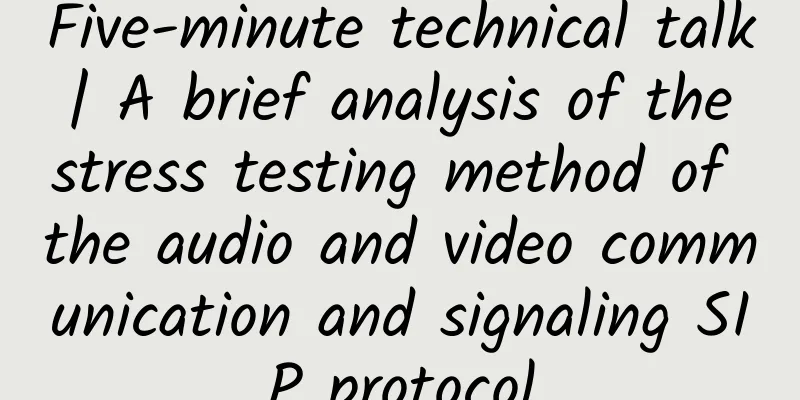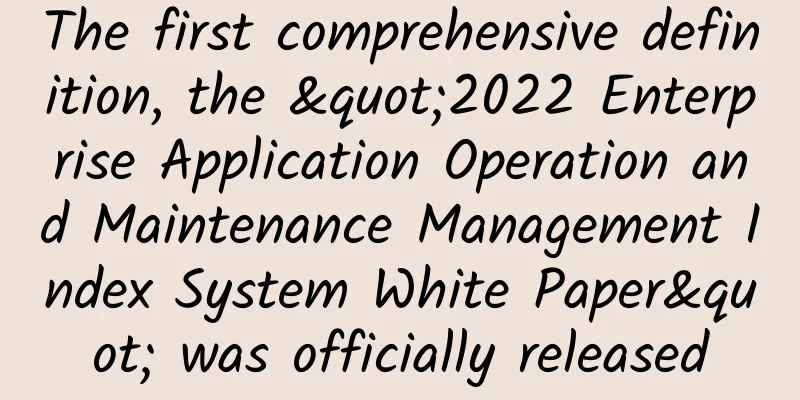Five-minute technical talk | A brief analysis of the stress testing method of the audio and video communication and signaling SIP protocol

Part 01Audio and video communication processAudio and video communication technology relies on core audio and video encoding and decoding, channel transmission, network scheduling and other capabilities to provide users with low-latency, high-quality audio and video content. The complete process of audio and video communication includes the following steps: pre- and post-processing, acquisition, encoding, transmission, decoding, buffering, rendering, etc. Figure 1 Audio and video communication process Part 02Audio and video communication related protocolsThe protocols involved in audio and video communication are: RTP, RTCP, RTMP, RTSP, HTTP, HLS, SRT, SIP. RTP and RTCP are transport layer protocols, which rely on the underlying UDP protocol and are often used in conjunction with RTS live broadcast; RTSP, RTMP, HLS, SRT are application layer media transmission protocols, which are often used for live broadcast, interactive live broadcast, on-demand, etc.; SIP is a signaling control protocol that relies on the underlying UDP protocol and is used for media session initiation, termination, and modification control. Table 1 Details of audio and video communication related protocols Computer networks use a hierarchical design method. Layers are connected through inter-layer interfaces. Each layer completes a function through a specific protocol. Multiple layers are superimposed to complete the sending and receiving of the entire information. The relationship between the media communication protocol and the OSI protocol architecture is as follows: Figure 2 Relationship between media communication protocols and OSI protocol architecture Part 03Central signaling control service based on SIPCloud Desk SIP (Session Initiation Protocol) is an application layer session initiation protocol that can be used to initiate, terminate, and modify media sessions. It is an important protocol in NGN, the next generation network, and a multimedia communication protocol developed by IETF. Participants in a session can communicate through multicast, mesh unicast, or a mixture of the two. Signaling refers to control instructions in a communication system, such as status reporting, configuration parameter distribution, and network resource scheduling. It is an important part of achieving audio and video communication. To achieve audio and video communication, it is necessary to exchange information through a signaling server: media information, network information, and specific services (for example, streaming, pausing, joining a room, muting, etc.) Figure 3 Signaling control service process Media information: Before the two ends communicate, the SDP (Session Description Protocol) session description protocol is used to understand the capabilities of both parties. The SDP media information carries what the codec is, whether audio and video are supported, what the encoding method is, etc. picture picture Figure 4 Key attributes in the SDP session description protocol Network information: When A communicates with B, the network-related information is first transmitted to the signaling server. The server helps you exchange it to the other end. After the other end gets your information, if it is in the same LAN, it will be transmitted directly through P2P. If not, it will first perform P2P traversal to see if it can be connected. If it can be connected, it will be transmitted. If not, it will be transferred. Part 04SIPP Performance TestBefore the SIPP test process, let's first understand the SIP session creation/termination process: 1. The caller sends a SIP INVITE request message (with SDP) to the called party to request to establish a session 2. The called party returns a SIP 200 OK response message (with SDP) to accept the session establishment request 3. The calling party sends a SIP ACK request message to confirm the establishment of the session. 4. Either party in the session can send a SIP BYE request message to request to end the session; 5. The other party returns a SIP 200 OK response message to accept the session end request. Figure 5 SIP session creation/termination process SIPP can be used to test many real SIP devices, such as SIP proxy, B2BUAS, SIP server, SIP/X gateway, SIPPBX, etc. It can simulate tens of millions of SIP proxies calling your SIP system. ❖ Taking UAC simulation as an example, the test steps are: 1. User operation port equipment management and control functions, such as streaming, pausing, PTZ control, etc. 2.xshell connects to the server where the signaling is located and executes the packet capture command tcpdump -i any -s 0 -w xx.pcap 3. Use xftp to synchronize the captured packet xx.pcap file to the local computer and use wireshark to view it. 4. Write a sipp script based on the sip interaction message (as shown in Figure 1 on the right) 5. Place the uac script in the server directory where sipp is deployed and execute the following command: 6.sipp -i 172.xx.xx.86 -p 5xxx5 -sf uac3.xml -inf data.csv 172.xxx.xxx.38:5xx0 -r 1 -l 10 -m 20 Figure 6 SIPP performance test script writing Part 05ConclusionWith the rapid development of the new generation of information technology, we have entered a new era of intelligence. As a quality assurance department, we need to have a deep understanding of the technologies involved in the business, and explore quality assurance methods to safeguard the development of the home security ecosystem business. |
>>: By 2027, global 5G IoT roaming connections will reach 142 million
Recommend
Analysis of the operating data of the three major operators in October: the growth momentum of 5G package users remains rapid
Recently, the operating data of the three major o...
As the strongest voice in the field of enterprise communications, Youyin Communications has been focusing on this for 13 years!
[51CTO.com original article] Every Sunday at 8 pm...
In the 5G era, where will the 2G-based temperature and humidity sensors go?
[[349400]] With the construction of 5G network ba...
WeChat Pay received the most complaints, and Alipay had the highest satisfaction, but Jack Ma was not happy!
[[222946]] Activities surrounding "3.15"...
Kerlink and Radio Bridge provide LoRaWAN solutions for private IoT networks
According to recent announcements, Kerlink and Ra...
Website monitoring solutions you should know
In today's world of rapid digital development...
IPv6 deployment speeds up, China enters a critical turning point in the game of network sovereignty
Cai Yiqun told reporters that the deployment of I...
Grasp the pulse of the times and serve industrial development | Information technology innovation to promote new infrastructure sub-forum was successfully held
On November 27, the "2020 China Tongming Lak...
UUUVPS newly launched Los Angeles AS9929 line VPS with 15% discount, native IP monthly payment starts from 33 yuan
UUUVPS (Sanyou Cloud) has newly launched the AS99...
The role of 5G in shaping the future of smart cities
The advent of 5G technology will revolutionize th...
What power will the combination of 5G and intelligent automation bring?
It can be said that 5G and intelligent automation...
Summary information: Hengchuang Technology/Wuyou Cloud/Hengtian Cloud/Ceraus/ServerSuper
At the beginning of 2022, we received New Year pr...
Global Power over Ethernet Lighting Solutions
The world of smart buildings is undergoing a majo...
5G or WiFi 6? Tips for choosing the best wireless network solution
Over the past five years, IT professionals who fo...
The Impact of WiFi Chipsets on Internet Speed and Performance
In today's fast-paced digital world, a stable...








![[Black Friday] AlphaVPS: VPS annual payment starts from 9.99 euros, AMD EYPC+NVMe series starts from €18.99/year, Los Angeles/Bulgaria data center available](/upload/images/67cac241028cf.webp)
